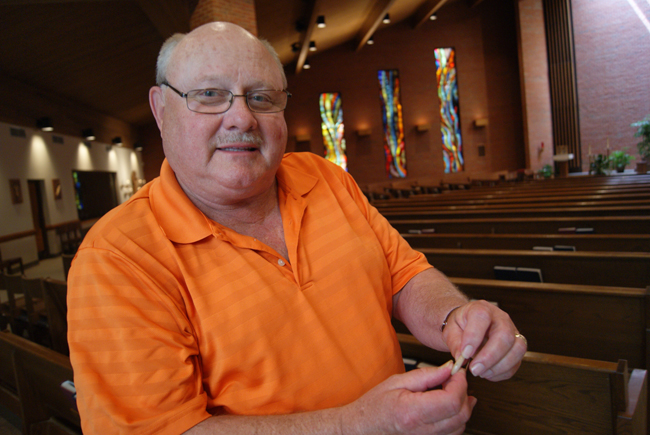By SUZANNE KOZIATEK
Staff writer
When Tom Goller began to lose his hearing, he says it took a toll on his spiritual life. Attending Mass at St. Nicholas Roman Catholic Church in O’Fallon, he often couldn’t hear what was going on, or catch the nuances of the readings or the homily.
“Father Bill (Msgr. William Hitpas) might say something and everyone would chuckle, and I’d wonder what I’d missed,” Goller says.
Switching to a hearing aid helped, but it magnified everything around him – crowd noises, coughs, crying babies.
Now, when Goller enters the sanctuary, he reaches up to his hearing aid, presses a tiny button, and “I can hear super clearly. It removes all the background noise and it’s like you can hear Father speaking to you personally.
“It’s pure heaven.”
The difference is a new system at St. Nicholas that customizes sound levels to users’ own hearing aid prescriptions. The “induction loop system” is unobtrusive – literally a large loop of copper wire under the carpeting that surrounds the pews, enabling users to sit anywhere in the church they like.
The loop creates a very mild magnetic field that connects users to a broadcast of whatever comes through the church’s microphones, including lectors, musicians and the priest, says Anne Byrnes, an audiologist and parishioner at St. Nicholas who proposed the system to church leaders. In addition, it muffles background noise during Mass.
Byrnes says the signal is available to anyone whose hearing aid contains a telecoil, which is now found in 60 to 70 percent of hearing aids on the market. Those who don’t have hearing aids also can receive the signal by using a headset provided by the church.
It’s hard to know how many parishioners at St. Nicholas are using the system, since they can access it so discreetly, says Ann Daniels, who is business administrator for the church. Goller estimates that at least a dozen people he knows have started using it since the church installed it in January.
Daniels says the church previously had a different type of system, one that used an FM radio transmitter and required users to wear headsets attached to receivers. However, it did nothing about background noise, and some people were uncomfortable using the headsets. Goller was one of them.
“I was too vain,” he admits. “I didn’t want to be known as the deaf guy.” He notes that many users also didn’t like the headsets because the noise from them could be heard by people around them.
When the new system was introduced, he went to his doctor to determine whether his hearing aid had the necessary telecoil. It did, and Goller said it took only a few minutes to activate it. Because it works through his own hearing aid, it’s calibrated to his hearing prescription.
The system also works with cochlear implants and Byrnes says it can be used with the headsets for children or adults with attention difficulties, since it focuses the listener’s attention on the microphones. Daniels notes that people who need a headset can use their own ear buds with the device instead.
Goller says being able to hear clearly has brought him more fully into Sunday worship.
“The music coming through the microphone is so sweet, and hearing the Eucharistic Prayer is just wonderful,” he says. “It’s enhanced my prayer life totally.”
He says he’s heard of parishioners bringing parents back to church who hadn’t attended in years because they couldn’t hear well. “And they’re part of the Mass now.”
Daniels says she’s also gotten calls from people outside the parish interested in attending because they heard about the loop system. A sign posted in the church informs visitors that the system is available.
The new system was more expensive than the old one – about $13,000, compared with about $2,500-$4,000 for an FM system, Daniels says. But she says St.
Nicholas’ parish council never hesitated, once they realized what an improvement it would make in the experience of its parishioners with hearing loss.
The only holdup was waiting until the church was ready to put in new carpeting. Installing the system required them to cut a slot in the cement floor of the church, insert the loop and seal it in.
But Byrnes says the loop should last as long as the floor does, meaning it’s an investment that will pay off for parishioners for years to come.
Anyone interested in learning more about how to use hearing loop technology in their own church can contact Ann Daniels, business administrator for St. Nicholas Catholic Church, at 618-632-1797 or busadmin@stnicholasofallon.org
Funding for this story was provided by The Wilke Family Fund.







